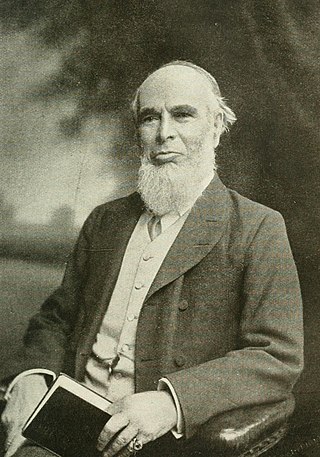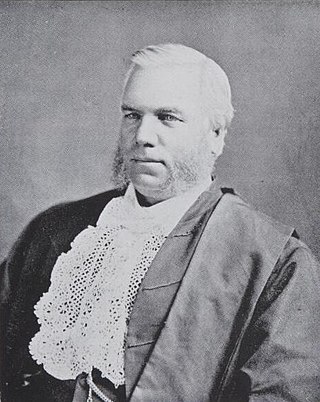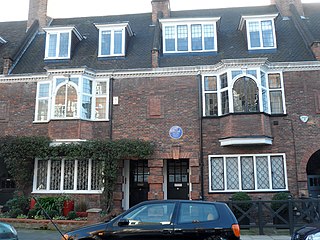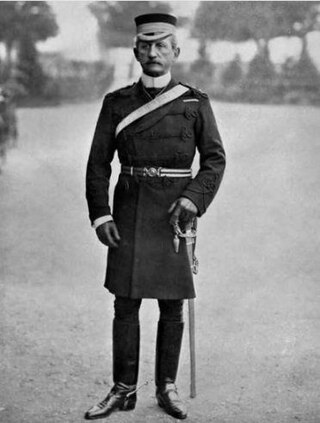Related Research Articles

James Hutchison Stirling was a Scottish idealist philosopher and physician. His work The Secret of Hegel gave great impetus to the study of Hegelian philosophy both in Britain and in the United States, and it was also accepted as an authoritative work on Hegel's philosophy in Germany and Italy. The book helped to create the philosophical movement known as British idealism.

Leonard Henry Courtney, 1st Baron Courtney of Penwith was a radical British politician, and an academic, who became famous after being advocate of proportional representation in Parliament and acting as an opponent of imperialism and militarism.

Larbert railway station is a railway station serving Larbert near Falkirk, Scotland.

Stirling railway station is a railway station located in Stirling, Scotland. It is located on the former Caledonian Railway main line between Glasgow and Perth. It is the junction for the branch line to Alloa and Dunfermline via Kincardine and is also served by trains on the Edinburgh to Dunblane Line and long-distance services to Dundee and Aberdeen and to Inverness via the Highland Main Line.
Falkirk Burghs was a district of burghs constituency of the House of Commons of the Parliament of the United Kingdom from 1832 to 1918. The constituency comprised the burghs of Falkirk, Airdrie, Hamilton, Lanark and Linlithgow, lying in Stirlingshire, Lanarkshire and Linlithgowshire.
John James StevensonFRSE FSA FRIBA, usually referred to as J. J. Stevenson, was a British architect of the late-Victorian era. Born in Glasgow, he worked in Glasgow, Edinburgh and London. He is particularly associated with the British Queen Anne revival style.

Walter Goodman was an English painter, illustrator and author.

Sir William Milne was an Australian entrepreneur and politician, serving as the member for Onkaparinga in the South Australian House of Assembly from 1857 to 1868. He was elected to the South Australian Legislative Council in 1869, and was President of the South Australian Legislative Council from 25 July 1873 to 1881.

Henry Hamilton was an English playwright, lyricist and actor. He is best remembered for his musical theatre libretti, including The Duchess of Dantzic (1903), The School Girl (1903), Véronique (1905) and The Little Michus (1907), often adapting foreign works for the British stage.

William Percy (1820–1903) was a portrait artist of Manchester, England.

Onslow Square is a garden square in South Kensington, London, England.

Andrew McCullum (1821–1902) was a British landscape painter.
Walter Wood Robertson (1845–1907) was a 19th-century Scottish architect. From 1877 he was Principal Architect and Surveyor for Scotland for public buildings, specialising in large urban post offices.

Abraham Harrison Goodall LRIBA was a British architect based in Nottingham.

Mallord Street is a street in London, England in the Royal Borough of Kensington and Chelsea. It was named after Joseph Mallord William Turner who had lived in Chelsea. There are no other streets named Mallord Street in Great Britain.
The Brocks were family of artists in Cambridge at the end of the Victorian Era, throughout the Edwardian era and the Interwar period. The four brothers were professional painters and illustrators. Two brothers gained a large reputation with their illustrations for the works of Jane Austen and other English classics. One brother secured an honours degree in mathematics, a huge achievement at the time for someone from a lower-middle-class background. The three sisters had a much lower profile, in accordance with the social norms of the time. At least one of the sisters was a capable artist and poet, but it is not clear to what extent she earned her living from her art. The biographer of the family, Clifford Michael Kelly, started out with the intention of writing just about Charles and Henry, the most famous of them, but realised that all the siblings worked together and supported each other.

Wellington Square Baptist Church is a Baptist church in the centre of Hastings, a town and seaside resort in East Sussex, England. It was built in 1838 for a congregation which had previously been meeting for worship in hired premises, and it has been in continuous use since then. Rev. W. Barker, a long-serving minister in the 19th century, revived the church after it was split by a secession and later helped to establish Baptist chapels in two other parts of Hastings. The church forms the northwest corner of Wellington Square, one of the town's earliest residential developments, and its stuccoed Neoclassical exterior harmonises with the surrounding houses. Historic England has listed the church at Grade II* for its architectural and historical importance.

Colonel Sir George Malcolm Fox was Inspector General of Gymnasia at Aldershot, (1890-1897) and Director of Physical Training at the Military School, Aldershot.

The Dudley, Sedgley and Wolverhampton Tramway Company operated a tramway service between Wolverhampton and Dudley from 1883 to 1901.
Alexander George Oliphant was a Scottish painter, born in Grangemouth, Scotland. He won the Guthrie Award in 1936 with his work, the oil painting David Kerr Esq. In his later life he switched to illustrating comic books, working on the Eagle comic.
References
- 1 2 "(94) - Towns > Stirling > 1865-1866, 1870-1871, 1872-1873, 1881-1882 - Stirling directory > 1881-1882 - Scottish Directories - National Library of Scotland". digital.nls.uk.
- ↑ "Stirling Observer - Thursday 01 June 1865" – via British Newspaper Archive.
- 1 2 3 "The "Stirling Sentinel" portrait gallery". Stirling, Scotland : Cook & Wylie, [1897]. 9 September 1897 – via Internet Archive.
- ↑ "Falkirk Herald - Saturday 23 September 1905" – via British Newspaper Archive.
- ↑ "Falkirk Herald - Wednesday 10 April 1907" – via British Newspaper Archive.
- ↑ "Stirling Observer - Saturday 03 October 1885" – via British Newspaper Archive.